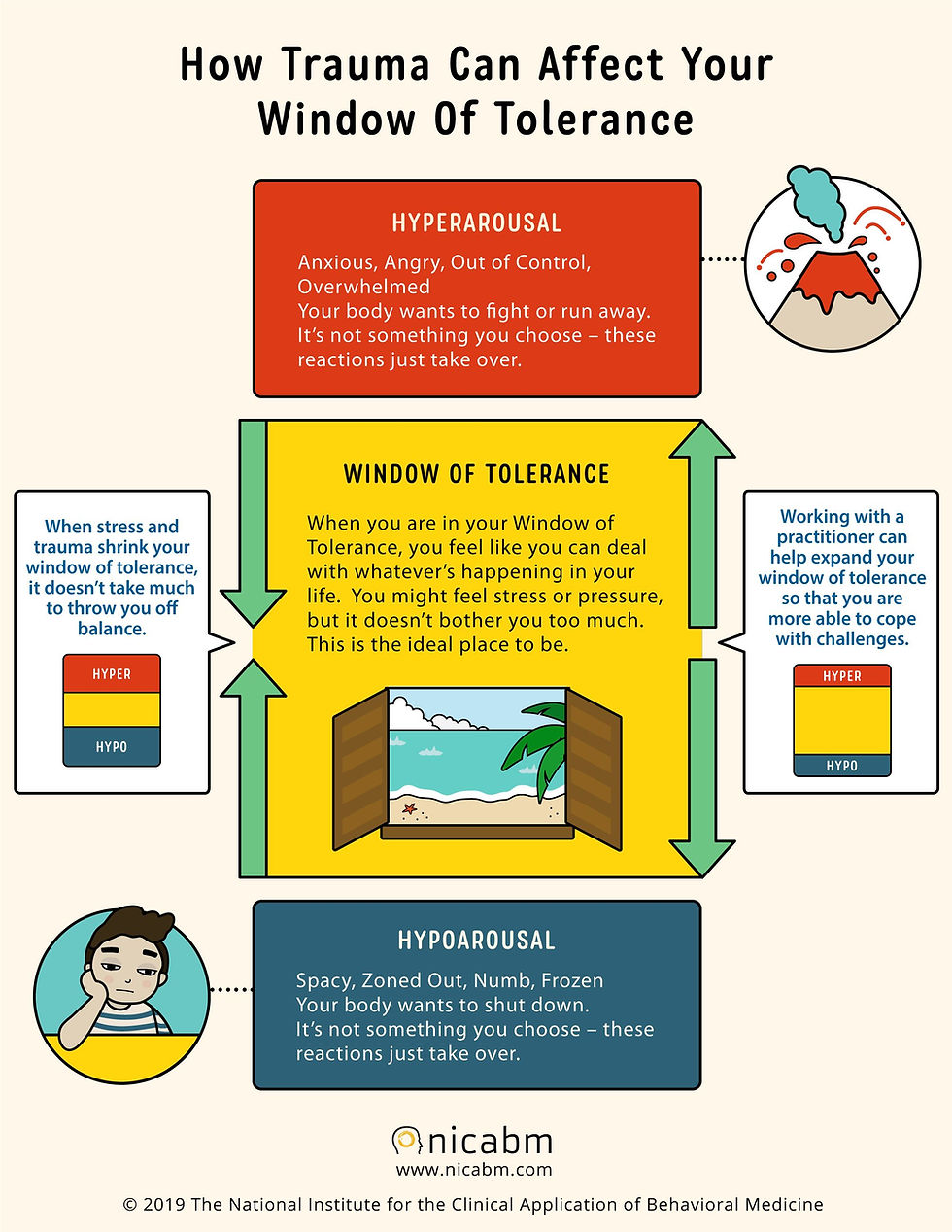What is the Window of Tolerance? What are We Tolerating?
- Raina LaGrand

- Feb 15, 2022
- 4 min read
Updated: Jun 15, 2022
The Window of Tolerance (WoT) is a simple model coined by Dr. Daniel Siegel for understanding the autonomic nervous system. The autonomic nervous system is responsible for the things our bodies do that we don’t have to think about; our most basic survival needs. Autonomic means involuntary.
The WoT is our optimal zone of arousal, or physiological activation. In our WoT we can think, feel, and function. Our experience at any given moment is tolerable. Even if we are stressed, we feel like we can help ourselves in some way, or access someone or something that will help us feel safer or more secure (this is called self-regulation).
Each of our windows are unique, and they can even change across time, setting, and more. What feels tolerable or safe enough for me, will be different than what’s tolerable or safe enough for you, and this can be different for both of us on different days or with different people or in different settings.
Our bodies are constantly processing information from our environment, inside our bodies, our minds, and more. We are hardwired to autonomically respond when faced with stressors and threats to our survival and wellbeing. These sources of stress or danger can be experiences we have, things we hear about, witness, and sometimes even just imagine or perceive. Our response is based on a number of factors, such as familiarity with a situation, self-efficacy, and ability to access resources such as people, things, coping skills, and more.
Hyper- and Hypoarousal
Hyperarousal is the zone above the WoT; hyper meaning more or extra. In hyperarousal, our sympathetic nervous system mobilizes our body towards protection. This is our fight-or-flight response.
Below the window is hypoarousal. We often refer to this as shutdown or collapse. Hypoarousal is mediated by the parasympathetic nervous system. In hyperarousal, our body immobilizes as a means to self-protect. Our bodymind sort of goes ‘Why bother?’ or ‘plays dead.’
We need our sympathetic nervous system so that we can play sports or express when our boundaries have been crossed, and we need our parasympathetic nervous system when it’s time to chill out and cuddle on the couch with a book or your boo. Hyper- and hypoarousal are just the most extreme ends of the arousal spectrum, so to speak.
The WoT is helpful for being curious about what our baseline is, what happens when we experience hyper- or hypoarousal, and what helps us change or become more comfortable with those experiences.
How the Window of Tolerance Can Help Us
In therapy, this model is especially effective to help educate clients, reduce shame, and increase confidence in our capacity to self-regulate. The WoT addresses normal, adaptive physiological and emotional responses to distress. In it’s response, our body is seeking an opportunity to complete the stress response cycle.
To explain, very simply, if a tiger walks through our backyard, we usually feel a lot better if we are able to outrun the tiger or perhaps even fight it off.
The challenge becomes when we are unable to help ourselves, extricate ourselves from distressing situations, or feel supported and seen. When we are overwhelmed by the speed, intensity, persistence, or volume of something distressing - and we lack the opportunity to move through it (physically, emotionally, etc.) - our bodymind essentially becomes stuck in that moment.
This is trauma. Not what happened or didn’t happen, but what happens in the body as a result.
As a result, people living with the effects of trauma often feel either persistently hyperaroused, or persistently hypoaroused. It’s also not uncommon for folks to feel like they bounce back and forth, unable to quite land in the middle.
So the WoT helps us develop a birds eye view of what’s happening and consider how we can help ourselves manage our experiences (e.g. self-regulate). It is also an evidence-based reminder that our experience of our WoT is adaptive as a result of our experiences, and that we are not defective or dysfunctional.
In sessions with clients, we sometimes flesh out our individual WoT by exploring:
What does it feel like to be in my WoT? Above? Below? What thoughts, emotions, body sensations, memories, and impulses arise?
What sends me into hyper- or hypoarousal?
What helps me get back in my WoT?
What helps me tolerate being above or below my WoT?
Other Models
While the WoT is quite comprehensive, without context and the right education in place, it’s been criticized for perpetuating the idea that optimal arousal and self-regulation are the gold-star in mental-emotional well-being.
Jane Clapp has implemented a new name in her practice, the Window of Capacity, as a way to explore our perception of our capacity for helping ourselves in distress. In doing so, she interrogates the idea that we should “tolerate” all sources of distress, when in fact many sources of distress are embedded within systems of oppression and our arousal response is therefore…well, responsive and adaptive and even hella appropriate.
Kai Cheng Thom has proposed the Window of Transformation, to highlight how connection can occur in spite of relational conflict and all the things we feel (or don’t feel) in those circumstances.
In my next post I’ll be covering the Polyvagal Theory (PVT), another neuroscientific perspective on emotion regulation.
RESOURCES
Ogden, P., Minton, K., & Pain, C. (2006). Trauma and the body: A sensorimotor approach to psychotherapy. W. W. Norton & Company.
Siegel, Daniel J. The Developing Mind: How Relationships and the Brain Interact to Shape Who We Are. 2nd ed. New York: Guilford Press, 2012.
Jane Clapp’s website
Kai Cheng Thom’s website and a free workbook
Photo by Carlos Caamal from Pexels





Comments